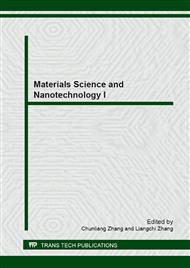p.333
p.337
p.342
p.346
p.351
p.358
p.362
p.368
p.373
Comparison of Two Methods of Solving Electromagnetic Parameters of Metamaterials with the Unit Cell of Symmetrically Arranged SRRs
Abstract:
Based on the principle that metamaterials-composite structured materials, in which permittivity(ε)and permeability(μ)are both negative in some frequencice, can be structured with periodically arranged SRRs and thin metallic wires which have negative effective permeability and negative effective permittivity respectively, the circular structure of SRRs was modified and a new split-ring resonator with symmetric structure was proposed. A detailed description of the design and simulation procedure was given simultaneously. According to the pattern of symmetric SRRs, ε and μ were calculated in analytic formula. Furthermore, metamaterials with symmetric SRRs was simulated with the software ANSOFT, and electromagnetic parameters were retried from S parameter. From analytic result and the retrieval result of electromagnetic parameters, left-handed behavior was obvious in a specific frequency range and the permittivity, the permeability and the index of refraction are all negative.
Info:
Periodical:
Pages:
351-357
Citation:
Online since:
December 2012
Authors:
Keywords:
Price:
Сopyright:
© 2013 Trans Tech Publications Ltd. All Rights Reserved
Share:
Citation:


